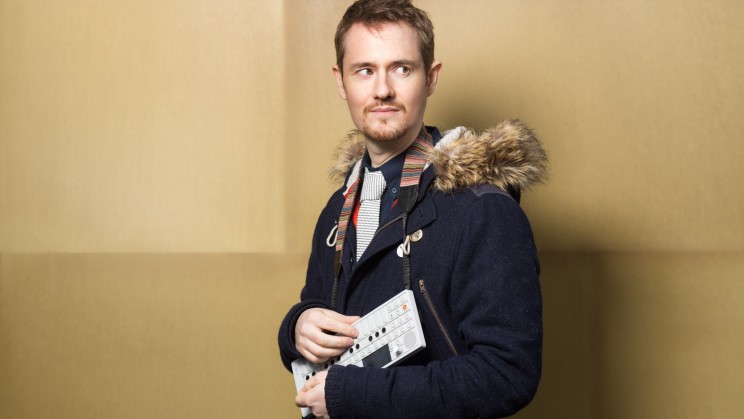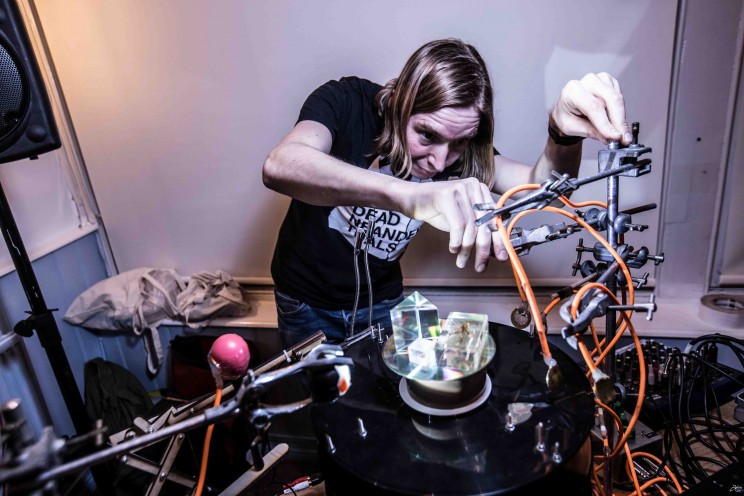Michael Forrest, photo by Mat Smith.
Michael Forrest is a London-based musician working in the fringes of popular music. Forrest’s background in physics and early exposure to computers led to a career in app development, but also fed into his comprehensive understanding of music technology. His practice involves writing electronic music with a popular appeal, which nevertheless compounds in complexity, as it is often reliant on Forrest learning new tools, and “usually comes across as ‘experimental’ sounding to most people”. His methodical approach to making music is also reflected in his visual art and video works.
Graham Dunning is a sound artist, musician and educator whose work primarily focuses on the tactile qualities of carrier formats. In Dunning’s hands vinyl records become materials for collage, techno is composed by mechanical means and memories are given license to haunt the artist’s archive. Dunning has performed and exhibited work in the UK, Europe, USA and New Zealand and is currently artist in residence at Galerie Paradise, Nantes.
Recently, Forrest and Dunning have collaborated together on a music video, Computer Screen – Mechanical Techno Remix, that meticulously reveals the process behind Dunning’s Mechanical Techno project. This approach is hardly surprising as both artists are vehemently against using laptops in their own live performances. In fact, back in May, Forrest released the first episode of his Leaving The Laptop web series, which explores the culture behind live electronic music performance. You can watch both videos below, but not before you read our interview with the artists.
IKLECTIK: Who came up with the idea of illustrating Graham’s process?
Graham Dunning: Michael asked me to do a remix of one of his tunes, Computer Screen, and we thought it’d be good to do a ‘making of’ type video, as the mechanical techno setup is so visual. I had originally thought it would be a fairly straightforward documentation type thing, but it quickly grew into a much bigger project once we started bouncing ideas around.
Was there a reason for going down the DIY cut-and-paste route?
GD: We spent a day working in the studio together with me making the music and Michael orchestrating the filming. The process for me relies on improvisation. It’s important for me that the mixdown is done live and without any edits or overdubs, it’s a physical remix in the strict tradition of a dub version. We recorded several takes of the remix and settled on this version as the best one. Unfortunately, it was over nine minutes long, which meant Michael had a big challenge to make a video to hold people’s attention for that long.
Michael Forrest: Graham’s studio was a little confined, so we couldn’t get any good wide shots! Without an establishing shot it was hard to get any context for all the close-up macro shots, so I had to resort to these diagrams.
Graham Dunning, photo by Julien Kerduff.
GD: We discussed various ways of visualising the setup of the gear, and went through different iterations of how it would look: the DIY corkboard thing seemed to make sense with the overall feel of the project. Michel did all the work animating and filming the cutaways.
MF: I experimented with computer graphics but that wasn’t really in the spirit of Graham’s work, so I printed things on paper and shot everything on a cork board in my studio. It was about mid-way through editing that I realised I had to start on the diagrams to make the pacing work. It really wasn’t planned that way from the start, other than wanting to make it a bit Wes Anderson, with everything being neat and orthogonal, which is definitely not what we ended up with!
How long did it take to make?
GD: Michael worked on it full time for about three weeks. I occasionally hung around making annoying comments and fiddling with things on his shelves.
Can you talk us through the production process and all those trippy visuals that segue between scenes?
MF: First we shot the remix itself on a few different cameras. We had an iPhone and a GoPro suspended above Graham’s rig. I followed the action on my DSLR, with a macro lens, as Graham performed the track. We did a few takes but most of the footage is from the real performance.
I did an initial edit the first week and brought it back to Graham’s studio. Once there, we took some pictures of each object in isolation, without being necessarily clear on how that would be used.
GD: The trippy visuals are from a 90s vision mixer. It has several quite cheesy effects, but you can also force it to feedback which gives all kinds of odd rainbow patterns. We did a few takes with us both live tweaking, playing the original footage into one channel with feedback on the other channel. It’s something I use in some of my own videos and, to some extent, the same approach I use for live visuals, so it made sense for the video. Kind of a visual equivalent to the audio mixing process.
Have you thought or talked about collaborating in a live AV setting, with Graham on machines and Michael on visuals?
MF: Not really. I’m too fixated on my own music! I don’t really think Graham’s setup needs to be augmented with abstract visuals though. He’s doing nicely pointing CCTV cameras at the rig, which seems more than enough to me. Just letting people get a look at what’s going on is all that’s needed, in my opinion. It all speaks for itself.
GD: I think each of us is a kind of one-man band. We’re both happy to try and do everything all at once!
Michael, regarding your Problem With Laptops video, I get the overbearing sense that you’re being a touch ironic. Am I correct?
MF: Of course, I would be completely lost without my laptop in most situations. It’s the lynchpin of just about everything I do. I’m reacting to the fact that I’ve felt confined to a laptop screen for years and years to do anything, but now technology has reached the point where I’ve been able to free myself from the laptop when playing live music.
I made the video to set the stage for a series which shares some of my experiences using alternatives over the last few years, but it’s not particularly easy yet, so I wanted to release a ‘manifesto’ first and I may have over-egged it a little.
What has the reaction to the laptop video been like so far?
The discussions I’ve seen have been overwhelmingly positive and constructive. A lot of people take issue with my hardline, but I think they can understand why. It’s sparked a lot of debate. Earlier cuts were a lot more adversarial, but I’m glad the final cut had enough humour and empathy that nobody took it too personally.
Have the YouTube trolls managed to sway your opinions regarding laptops in electronic music?
MF: Honestly, I haven’t had any real trolling at all on this so far! The worst I’ve seen is a dismissive attitude from one or two people. I am not really swayed at all. I’ve been laptop-free in my live sets for at least five years, so my attitude is deeply rooted. Before that, I had spent a lot of energy and programming skills trying to get a laptop to behave the way I wanted it to. I’m in no hurry to return to that. I’ve been focused on the needs of my own particular music though so maybe the people who say “I can’t play my music without a laptop” will turn out to be right, but I take that as a challenge more than a reason to retreat.
What’s next in your series on live electronic music?
MF: I just need to get into the nitty gritty of the alternatives. I’m going to be talking about iPads, Volcas, OctaTracks, modular synths, PO-12s, DJ hardware and things like that, as well as some custom Arduino ideas. I have a little Arduino setup, which makes my OctaTrack control the stage lighting.
I also want to get a series on live streaming started. I was going to do that before anything else, but the response to this video has been so strong that my subscribers might be disappointed if I make them wait too long!
Michael Forrest’s ‘Computer Screen’ single is out now via Bandcamp. Keep up to date with his activities here. Graham Dunning is exhibiting at Global Forrest 2017, in Sankt Georgen im Schwarzwald, Germany until December. You can find out more about Dunning from his website.




